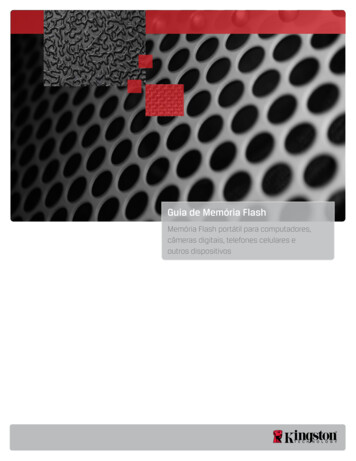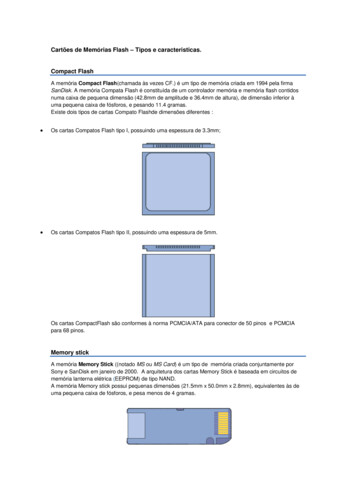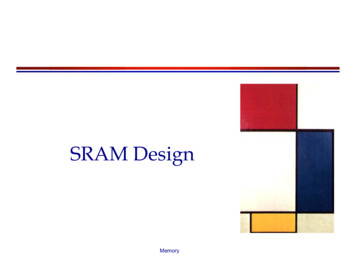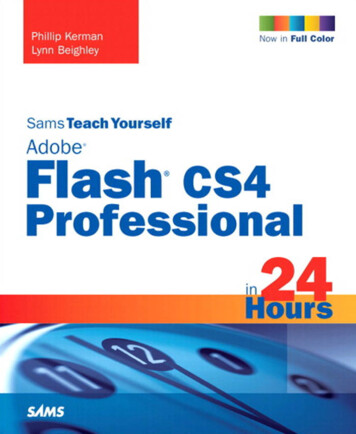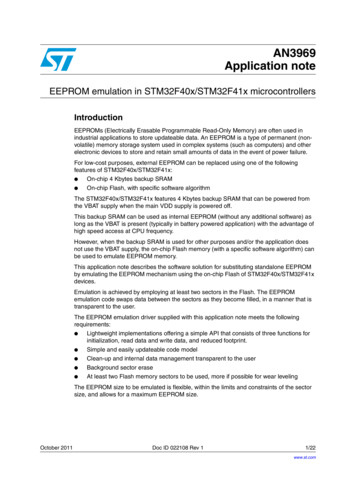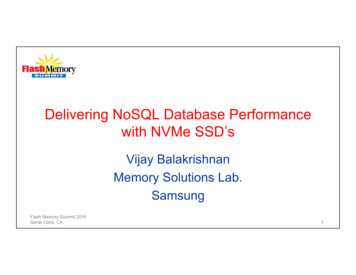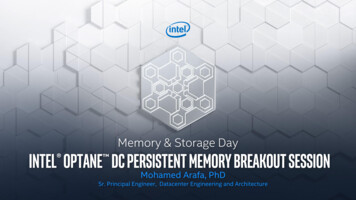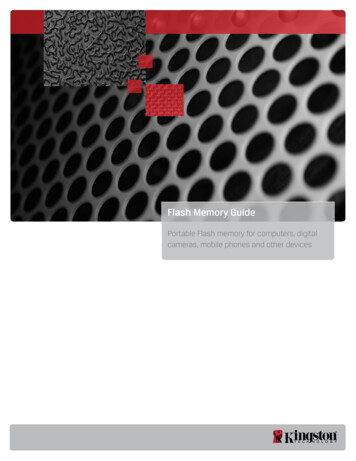
Transcription
Flash Memory GuidePortable Flash memory for computers, digitalcameras, mobile phones and other devices
Flash Memory GuideKingston , the world’s leading independent manufacturer of memory products, offers a broad range of Flash cards,USB Flash drives and Solid-State Drives (SSD) (collectively called Flash storage devices) that employ Flash memorychips for storage. The purpose of this guide is to explain the various technologies and Flash memory offerings thatare available.Note: Due to Flash technology changes, specifications listed in this document are subject to change without notice1.0 Flash Memory: Empowering A New Generation of Flash Storage DevicesToshiba invented Flash memory in the 1980s as a new memory technology that allowed stored data to be savedeven when the memory device was disconnected from its power source. Since then, Flash memory technology hasevolved into the preferred storage media for a variety of consumer and industrial devices.In consumer devices, Flash memory is widely used in: Notebook computersTabletsGlobal Positioning Systems (GPS)Solid-state music players such asMP3 players Personal computersDigital camerasMobile phonesElectronic musical instrumentsTelevision set-top boxesFlash memory is also used in many industrial applications where reliability and data retention in power-off situationsare key requirements, such as in: Security systemsEmbedded computersNetworking and communication productsRetail management products(e.g., handheld scanners) Military systemsSolid-state drivesWireless communication devicesPoint of Sale Devices2.0 SSD, Flash Card and USB Flash Drive CapacitySome of a Flash storage device’s listed capacity is used for formatting and other functions and thus is not availablefor data storage.When a Flash storage device is designed and manufactured, steps are taken to ensure that the device operatesreliably and to permit the host device (computer, digital camera, tablets, mobile phone, etc.) to access the memorycells — i.e., to store and retrieve data on the Flash storage device. Formatting includes the following operations:1. Testing each memory cell in the Flash storage device.2. Identifying all defective cells and taking steps to ensure that no data will be written to or read from a defective cell.3. Reserving some cells to serve as “spares.” Flash memory cells have a long but finite lifetime. Therefore, some cellsare held in reserve to replace any memory cells that may fail over time.1
Flash Memory Guide4. Creating a File Allocation Table (FAT) or other directory. To enable Flash devices to conveniently store and accesscustomer files, a file management system must be created to allow any device or computer to identify the filesstored in the Flash storage device. The most common type of file management system for Flash storage devicesis the File Allocation Table (FAT), which is also used on hard drives.5. Reserving some cells for use by the Flash storage device’s controller, e.g., for storing firmware updates and othercontroller-specific information.6. Where applicable, reserving some cells for special features. For example, the specification for Secure Digital (SD)cards requires reserved areas to support special copy protection and security features.3.0 Features of Kingston’s Flash Storage ProductsKingston’s Flash storage devices offer many advantages for both consumer and industrial applications: Flash Storage Device Warranty: Kingston warrants that its Flash storage devices are free from defects in materialand workmanship for the period specified below:Product Lifetime Warranty: The following Kingston products are covered by this warranty for the life ofthe product: Memory modules including ValueRAM , HyperX , Retail Memory and Kingston system-specificmemory; Flash memory cards (e.g., Secure Digital, Secure Digital HC and XC, CompactFlash, MultiMediaCard,SmartMedia) and Flash adapters.Five-Year Warranty: The following Kingston products are covered by this warranty for a period of five years fromthe date of purchase by the original end user customer: USB DataTraveler drives and SSDNow KC100 (SolidState Drives).Three-Year Warranty: The following Kingston products are covered by this warranty for a period of threeyears from the date of purchase by the original end user customer: SSDNow (Solid State Drives) except for theSSDNow KC100.Two-Year Warranty: The following Kingston products are covered by this warranty for a period of two yearsfrom the date of purchase by the original end user customer: MobileLite, microSD Reader, Media Reader WiDrive and products under the Kingston Private Logo Program. Kingston Private Logo Program products arelimited to credit or refund during the two-year warranty period.One-Year Warranty: The following Kingston products are covered by this warranty for a period of one year fromthe date of purchase by the original end user customer: DataTraveler Accessory Kit, Wi-Drive, TravelLite SD/MMCReader and HyperX Fan.For further details, see Kingston.com/company/warranty.asp Solid State: Flash storage devices, as semiconductor storage devices, have no moving parts and thereby are notsubject to the mechanical failure issues of hard drives. Their overall data reliability enabled them to dominate theconvenience-oriented portable memory products market, operating silently with a zero decibel noise level. Small Physical Size (or Form Factor): Flash storage devices are designed to be easily transported. Convenience isan important criterion, especially for consumer and corporate applications.2
Flash Memory Guide High Data Reliability: Flash memory is very reliable and many of the Flash storage device types also include ErrorCorrection Code (ECC) checking and advanced wear leveling.For example, Kingston’s CompactFlash cards have a rated error specification of less than one (1) bit in1,000,000,000,000,000 bits read (1 bit per 1015 bits read). Kingston Flash Data Retention: Kingston Flash Storage Devices primarily use MLC/TLC Flash Memory. Dataretention on Flash memory is dynamic since the amount of time the memory has been cycled affects dataretention. Important information should always be backed up on other media for long-term safekeeping. Wear-Leveling Technology: Kingston Flash storage devices incorporate controllers utilizing advanced wearleveling technology, which distributes the number of P/E cycles (program/erase) across the Flash memory evenly.Wear-leveling thus extends the useful life of a Flash memory card (for details, please see Kingston Flash CellEndurance section, next). Flash Cell Endurance: Non-Volatile Flash Memory cells have a finite number of program/erase (p/e) cycles. Simplyput, every time data is written to or erased from a Flash Storage Device the number of program/erase cyclesdecrease and are eventually used up to the point that the Flash memory is no longer usable. For Multi-Level Cell (MLC) Flash, between 3000 and 5000 write cycles per physical sector based on currentlithography process (24nm and 25nm) at the time of this writing. For Single-Level Cell (SLC) Flash, up to 50,000write cycles per physical sector. For Triple-level Cell (TLC), up to 1,000 write cycles per physical sector. Lithographyof the Flash Memory Die plays a key role in cell endurance and decreases as the size of the die gets smaller. Write Amplification Factor: Write Amplification Factor or “WAF” is present in all Flash Storage Devices. The writeamplification factor is the difference in the amount of data written by the host to the Flash memory and theamount of actually data written to the Flash memory chips. All Flash devices write in full blocks, which means,that in order to write to a block that may already contain some data the Flash controller must move the existingdata in the block (usually to memory) and combine it with the new data and write all the data back to the Flashmemory. For example a 2MB file could be written by the host to the Flash device however 4MB of total data maybe written to the Flash memory to complete the write operation. In this case you would have a write amplificationfactor of 2. In some cases the WAF can be as high as 20 or 30. Automatic Bad Sector Remapping: Kingston Flash controllers automatically lock out sections with bad memorycells (“bad blocks”) and move the data to other sections (“space blocks”) to avoid data corruption. During factoryformatting (as described in Section 2), spare blocks are set aside on the Flash storage device for remapping badsectors over time to extend the useful life and reliability of the Flash storage device. High-Quality Connectors: Kingston’s Flash storage devices always use highly rated mating connectors to ensurelong life and reliable usage of the Flash memory device. Operating Temperature and Humidity:SSD: 0 – 70 C, Humidity: 85% RHUSB Flash Drives: 0 – 60 C, Humidity: 85% RHSD and Micro SD: -25 C – 85 C, Humidity: 5% to 95% RHCF Card: 0 – 60 C, Humidity: 95% RH3
Flash Memory GuideCard Readers: 0 – 70 C, Humidity 93%RHFor detailed product environmental specifications, check Kingston’s product pages and datasheets for moreinformation.1 Toshiba press release, “Toshiba America Electronic Components, Inc.Releases Performance Research on MLC NAND Flash Memory for ConsumerApplications,” May 10, 2004 High-Capacity: Flash storage devices can provide large storage capacities in a very small form factor. Thisflexibility makes them ideal for consumer uses, such as digital film or storage for MP3 music, where portabilityand convenience are important.Please note: Some of the listed capacity is used for formatting and other functions and thus is not availablefor data storage. Please see Section 2 for details. High-Performance: Kingston’s Elite Pro/Ultimate Flash cards and Hi-Speed/SuperSpeed DataTraveler USB Flashdrives are faster than many standard Flash products and many competitive products. Kingston’s engineers testand select high-performance controllers to ensure that Kingston’s Flash cards are among the performance leaders.Please see the Appendix for information about USB, Hi-Speed and Super Speed USB performance. Kingstonstandard Flash products offer moderate performance levels for general purpose applications. Low Power Consumption: Unlike standard DRAM memory that needs to be constantly powered on to maintainits data, Flash memory is non-volatile and does not require power to maintain its data. Flash memory’s low powerconsumption results in longer battery life for the host device. Plug-and-Play Support: Kingston’s Flash memory line supports plug and play. With plug-and-play technology andcompatible computer operating systems, a Flash storage device can be inserted into a computer or a Flash mediareader and be quickly recognized and accessed by the computer. Hot-Swapping Support:Hot-swapping allows for plugging or unplugging Flash storage devices into a compatiblecomputer or reader without needing to power off and restart the computer. This feature enhances the portabilityand convenience of Flash storage devices for transferring data, pictures or music between two computers ordevices.4.0 Non-Volatile NOR and NAND Flash TechnologiesUnlike Dynamic Random Access Memory (DRAM), Flash memory is non-volatile. Non-volatile memory retains dataeven without being powered-on. For example, when a computer is turned off, all data that was in the computer’sDRAM memory is lost; however, when a Flash storage device is removed from a digital camera, all data (and pictures)remains saved on the Flash storage device. The ability to retain data is key for Flash memory applications such asdigital film for digital cameras, mobile phones, tablets and other transportable devices.There are two major technologies of Flash memory: NOR and NAND. Each technology has strengths that make it4
Flash Memory Guideideal for different kinds of applications, as summarized in the following table:NOR FlashYesNAND FlashYesPage-Mode Data AccessNoYesRandom Byte Level AccessYesNoNetworking Device MemoryIndustrial StorageHigh-speed AccessTypical Uses4.1 NOR Flash MemoryNOR, named after the specific data mapping (Not OR), is a high-speed Flash technology. NOR Flash memory provideshigh-speed random-access capabilities, being able to read and write data in specific locations in the memory withouthaving to access the memory in sequential mode. Unlike NAND Flash, NOR Flash allows the retrieval of data as smallas a single byte. NOR Flash excels in applications where data is randomly retrieved or written. NOR is most oftenfound built into cellular phones (to store the phone’s operating system) and PDAs and is also used in computers tostore the BIOS program that runs to provide the start-up functionality.4.2 NAND Flash MemoryNAND Flash was invented after NOR Flash, and is named after the specific mapping technology used for data (NotAND). NAND Flash memory reads and writes in high-speed, sequential mode, handling data in small, block sizes(“pages”). NAND Flash can retrieve or write data as single pages, but cannot retrieve individual bytes like NOR Flash.NAND Flash memory is commonly found in solid-state hard drives, audio and video Flash media devices, televisionset-top boxes, digital cameras, cell phones (for data storage) and other devices where data is generally written orread sequentially.For example, most digital cameras use NAND-Flash based digital film, as pictures are usually taken and storedsequentially. NAND-Flash is also more efficient when pictures are read back, as it transfers whole pages of data veryquickly. As a sequential storage medium, NAND Flash is ideal for data storage.NAND Flash memory is less expensive than NOR Flash memory, and can accommodate more storage capacity in thesame die size.Flash memory which stores a single bit per cell (e.g., a value of “0” or “1” per cell) is known as Single-Level Cell (SLC)Flash.5.0 Die-Stacking and Multi-Level Cell/Multi-Bit Cell Flash technologiesIn order to economically increase the amount of bit-storage that a Flash memory chip can accommodate,manufacturers utilize die-stacking and multi-level cell or multi-bit cell technologies. These technologies result in aFlash memory chip having the capability to store more data in a single chip.5.1 Die-StackingMany semiconductor manufacturers use a “die-stacking” technique to double a Flash memory chip’s capacity. Afterthe semiconductor wafer fabrication process, they cut out the Flash memory silicon “die” and then attach or stacktwo separate dies together.5
Flash Memory GuideFor example, when a semiconductor manufacturer stacks two 16 gigabit dies together, they form a single 32 gigabitFlash memory chip.Die-stacking allows for cost-reduced chip alternatives to the larger-capacity, single-die chips (called “monolithic”chips). Stacking two 16-gigabit chips together, for example, typically costs far less than buying a low-volumemonolithic 32-gigabit chip. The 32-gigabit chip can then be used to build a 4GB Flash card (single chip card), or a8GB Flash card (two chips on one card).Die-stacking is similar to the DRAM chip-stacking technology that Kingston utilizes to produce high-end servermodules. As a result, Kingston’s die-stacked Flash cards are reliable and deliver high performance.5.2 Multi-Level Cell (MLC)/ Triple-Level Cell (TLC) Flash TechnologiesNAND and NOR Flash memory chips store one (1) bit value (a “0” or a “1”) in each cell. In multi-level Flash technology,two (2) values are stored into each cell. In triple-level Flash technology, three (3) values are stored into each cell.Kingston has incorporated both MLC/TLC Flash memory into its line of standard Flash cards, SSDs and DataTravelerUSB Flash drives.6.0 Flash Storage Device PerformanceFlash card storage device performance depends on the following three factors: The specific Flash memory chips used: Generally, there is a tradeoff between the high-speed and more expensiveSingle-Level Cell (SLC) Flash chips, and the standard speed and more affordable Multi-Level Cell (MLC)/TripleLevel Cell (TLC) or Multi-Bit Cell (MBC) Flash chips. The Flash storage device’s controller: Today’s Flash storage devices have a built-in Flash memory controller. Thisspecial chip manages the interface to the host device, and handles all the reads from and writes to the Flash chipson the Flash storage device. If the host controller is capable of supporting faster data transfer speeds, the useof optimized Flash controllers can result in significant time savings when reading or writing data into the Flashmemory. The host device to which the Flash storage device is connected to: If the host device (computer, digital camera,cell phones, etc.) is limited to specific read and write speeds, using faster Flash storage devices will not deliverhigher performance. For example, using a USB 3.0 Flash drive on a computer that supports only USB 2.0 speedswill not result in faster transfers. In addition, computers need to be properly configured to support faster transfersin both hardware and software. In the case of a PC, the system board will need to have built-in SuperSpeedUSB 3.0 connectors, and the Operating System (e.g., Windows) will also need to have the proper USB 3.0 driversinstalled in order to be able to support SuperSpeed USB transfers.For details on USB Performance, refer to Appendix A.Flash memory product manufacturers provide “x-speed” ratings for Flash cards. However, due to a lack of industrystandards, comparing different Flash products may prove difficult for consumers. For details, see kingston.com/Flash/xKingston works closely with global semiconductor and controller manufacturers to ensure that Kingston Flashdevices deliver superior price/performance to its customers. For enthusiasts and advanced customers demandingthe highest performance, Kingston offers the Elite Pro/Ultimate line of CompactFlash and SD cards, the DataTravelerSuperSpeed USB 3.0 Flash drives and HyperX SSDs.6
Flash Memory Guide7.0 Kingston’s Flash Product LinesThere are several types of Flash storage devices that are available from Kingston:-USB Flash Drive (DataTraveler )Secure Digital Cards (SD, SDHC, SDXC, microSD, microSDHC)CompactFlash CardseMMCSSD7.1 USB Flash DrivesIntroduced in 2002, USB Flash drives offer an incredible combination of high storage capacity, fast data transferrates, and great flexibility, all in the palm of your hand. Heralded as a floppy or CD driver alternative, USB drives havefar more storage capacity than that of a standard floppy disk or CD-ROM drive replacement. They provide an easymethod for quick downloads and transferring digital files to and from your computer or device.USB Flash drives incorporate NAND Flash and a controller in a capsulated case. USB Flash drives work with the vastmajority of computers and devices that incorporate the Universal Serial Bus interface, including most PCs, tablets,and MP3 players.Kingston offers a full line of DataTraveler Hi-Speed and Super Speed USB Flash drives. Some DataTraveler drives alsosupport password-protection and hardware-based AES encryption for improved security. For details, please visitkingston.com/Flash/dt chart.asp.7.2 CompactFlash (CF) CardsCF cards incorporate a controller and are about the size of a matchbook. CompactFlash cards incorporate anIntegrated Device Electronics (IDE) interface similar to hard drives and ATA PC Cards. Kingston is a member of theCompactFlash Association, which sets the specifications for CF cards.Kingston offers standard CompactFlash cards as well as high-performance Elite Pro and Ultimate lines.Kingston’s Elite Pro/Ultimate CompactFlash cards are among the fastest available in the industry. The high transferrate is ideal for use on newer devices such as high-megapixel digital cameras, to ensure that the cameras savepictures faster and are quickly ready for the next shot.CompactFlash cards come in Type I form factor:INTERFACEVOLTAGEPIN COUNTSIZE IN MMCompactFlash3.3 and 5 Volts5036.4 x 42.8 x 3.37.3 Secure Digital Cards (SD, SDHC, SDXC, microSD, microSDHC, microSDXC)Secure Digital, introduced in late 2001, is a second-generation derivative of the MultiMediaCard (MMC) standard (seesection 7.4).The Secure Digital format includes several important technological advancements over MMC. These include theaddition of cryptographic security protection for copyrighted data/music. The SD Card Association, of which Kingstonis an executive member, sets the specifications for Secure Digital cards.7
Flash Memory GuideSD cards are slightly thicker than the original MMC cards. This means that devices designed to support SD cards mayalso accept MMC cards (if the host device is not strictly limited to SD media for SD copy protection managementfeatures). However, devices exclusively designed for MMC cards will not support the thicker SD cards.Kingston offers standard SD cards as well as high-performance Ultimate SD cards to capture high-definition video.Secure Digital High Capacity (SDHC), starting at 4GB, and Secure Digital Extended Capacity (SDXC), starting at 64GB,offers larger volume data storage and optimized recording performance with support for FAT/FAT32/exFAT fileformats. In addition, Kingston SDHC and SDXC cards use speed “class” ratings known as Class 2, 4, 6 and 10 that delivera minimum data transfer rate for optimum performance with SDHC and SDXC devices. Although identical in size totoday’s standard SD card, the new SDHC and SDXC cards are designed differently and are only recognized by SDHCor SDXC host devices. To ensure compatibility, look for the SDHC and SDXC logo on cards and host devices (cameras,camcorders, etc.).microSD (SDC) are the mobile platform form factor of the SD card for use in cell phones and other portable devices.microSD are a fraction of the size of a standard SD card and, when used with the supplied adapter, can be used instandard SD device slots (for example, in Flash media readers).microSDHC cards offer higher storage for more music, more videos, more pictures, more games — more of everythingfor today’s mobile world. In addition, Kingston microSDHC cards use new speed “class” ratings known as Class 4 and10 that deliver a minimum data transfer rate for optimum performance with microSDHC devices. The microSDHCcard allows users to maximize storage for today’s revolutionary mobile devices.INTERFACEVOLTAGEPIN COUNTSIZE IN MMSecure Digital / SDHC2.7 – 3.3 Volts932 x 24 x 2.1Secure Digital / SDXC2.7 – 3.3 Volts920 x 21.5 x 1.4microSD / microSDHCmicroSDXC2.7 – 3.3 Volts815 x 11 x 17.4 Embedded MultiMediaCard (eMMC)Kingston eMMC is an Embedded Flash Drive (EFD) optimized for mobile handsets and consumer electronic devices.eMMC is a hybrid device combining an embedded Flash controller and MLC NAND memory with an industrystandard eMMC 4.XX interface.Kingston eMMC provides up to 128GB of NAND Flash memory for storage applications. The eMMC intelligentcontroller manages interface protocol, data storage retrieval, error correction code (ECC) algorithms, defect handlingdiagnostics, power management, clock control and many other processes and functions. eMMC Flash driveempowers mobile multimedia driven applications such as music, photo, video, TV, GPS, games, email, etc. TheeMMC architecture fully emulates a hard disk to the host processor, enabling read/write operations that are identicalto a standard, sector-based hard drive. In addition, Kingston’s eMMC controller employs virtual mapping, dynamicwear-leveling, static wear-leveling and automatic block management to ensure the highest data reliability whilemaximizing endurance.8
Flash Memory GuideINTERFACEVOLTAGEPIN COUNTSIZE IN MMeMMC 4.411.8 and 3.3 Volts153 & 169 BGA14 x 18 x 1.47.5 Solid-State Drives (SSD)A solid-state drive (SSD), is a data storage device that uses solid-state memory to store data with the intention ofproviding access in the same manner as a traditional hard disk drive (HDD). As of 2007 most SSDs use non-volitile,NAND-based Flash memory to retain data and contain no moving parts. Compared to HDDs, SSDs are typically lesssusceptible to physical shock, are silent, have lower access and latency times and deliver much higher performance.SSDs use the same interface and form factor as traditional hard drives thus making them easily replaceable in mostcomputer platforms.Kingston offers a broad range of solid-state drives to suit the needs of business professionals, consumers, systemintegrators and enthusiast. Kingston’s business class SSDs are some of the fastest in the industry and carry a longerwarranty. Kingston’s consumer and system builder SSDs offer a good balance of price and performance whileenthusiast will enjoy the ultra-fast performance and styling of Kingston’s HyperX SSDs.The Flash memory chips used in SSDs: There are primarily two types of Flash memory used in SSDs, Multi-LevelCell (MLC) and Single-Level Cell (SLC). Both types of Flash memory offer different performance and endurancecharacteristics. Due to the high cost of SLC Flash memory, MLC is becoming the more common Flash memory used inSSDs built for client-based notebook and desktop PCs. SSDs that are designed for servers will use a new Flash memoryprocess called Enterprise MLC Flash memory (eMLC) that will offer higher endurance and be more suitable for highend server workloads.SSD Endurance: SSD endurance is the amount of time an SSD can be expected to function normally given a writeworkload. SSD endurance is commonly classified in Total Bytes Written (TBW) to the drive. This is the total amount ofdata you can expect to write to the drive over its useful life time. Flash memory endurance is primarily reduced by dieshrinks in the NAND and by something called the “Write Amplification Factor” or WAF. WAF is the difference betweenHost Writes and the total amount of data written to the NAND per write operation. Flash memory devices like SSDswrite in full blocks. In order to write to a block that already contains some data requires the good data in the block tobe combined with the new data and rewritten to the Flash. For example, if 2GB of data is written to the SSD the actualdata written to the Flash may be 4GB. In this case the WAF is (2). Depending on the SSD controller and the type of databeing written (random or sequential) to the SSD, the WAF very from as low as .5 to has high as 20 or 30.SSD Storage Controllers: SSDs use sophisticated Flash controllers to communicate between the Serial ATA HostController and the Flash chips on the SSD. This special chip manages all the reads from and writes to the Flash memoryon the SSD. The SSD controller also manages other important functions such as wear-leveling and garbage collectionto extend the life of the drive and help maintain consistent performance levels over the life of the drive.Serial ATA (SATA) Host Interface: All of Kingston’s SSDs support the SATA host interface connection which allowsKingston SSDs to connect to most mainstream notebooks, desktop and server computers built within the last severalyears. Kingston SSDs are compatible with most SATA revision 2, 3Gbps and SATA revision 3, 6Gbps host controllers.Most SATA host controllers provide for backward compatibility however if a SATA host controller is limited to specificread and write speeds, using a faster SSD will not result in faster data transfers. For example if a SATA Rev. 3 SSD isattached to a SATA Rev. 2 host controller, data transfers will only be as fast as the host controller.9
Flash Memory GuideINTERFACEVOLTAGEPIN COUNTSIZE IN MMSATA Rev. 25 Volts22 Pin SATA69.85 x 100 x 9.5SATA Rev. 35 Volts22 Pin SATA69.85 x 100 x 9.57.6 mSATA (MO300) and Half-Slim (MO297) Solid State DrivesKingston offers integrators and system builders with a small form factor mSATA and Half-Slim SATA SSDs forcommercial applications.MO-300 – mSATA or Mini-SATA, was announced by the Serial ATA International Organization in September 2009.Applications include netbooks , ultrabooks and other devices that require a smaller solid-state drive. The connectoris similar in appearance to a PCI Express Mini Card interface, and is electrically compatible, however the data signalsneed to go to the sata host controller instead of the pci-express host controller. Not all mini PCIe connections supportSATA so check with your system provider for more details.MO-297 – Slim SATA, is a solid state drive with a purpose-built form factor that delivers great performance in astandard case-less form factor – and less than half the size of a 2.5” SSD. Slim SATA uses a standard SATA drive andpower connection as a 2.5” SSD which makes it compatible with a wide variety of host systems. Slim SATA is anindustry standard JEDEC form factor (MO-297) and provides (4) mounting locations to secure the drive to the system.INTERFACEVOLTAGEPIN COUNTSIZE IN MMMO-300, SATA Rev. 23.3 Volts52 Pin PCIe Mini Card50.8 x 30MO-297, SATA Rev. 25 Volts22 Pin SATA54 x 39Kingston works closely with global semiconductor and controller manufacturers to ensure that Kingston SSDs deliversuperior price/performance to its customers.8.0 Kingston Flash Media ReadersFlash media readers allow Flash storage devices to be used as portable storage for computers as well as for uploadingor downloading of pictures, music, and other data without requiring the original host device (such as a digital cameraor MP3 player), and without any additional drain on its batteries.Flash media readers can enable the transfer of data at higher speeds than a host device is capable of supporting; forexample, a USB reader will be much faster than a host device (such as a digital camera) using a serial interface. If ahost device does not support high-speed transfers, the faster reader will significantly reduce the data transfer times.Kingston offers Flash media readers for the convenient attachment of Flash storage devices to personal computersor notebooks.For Flash media, Kingston recommends the flexible and convenient Media Reader,
2.0 SSD, Flash Card and USB Flash Drive Capacity Some of a Flash storage device's listed capacity is used for formatting and other functions and thus is not available for data storage. When a Flash storage device is designed and manufactured, steps are taken to ensure that the device operates
